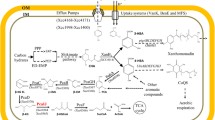Abstract
Rhizobia utilize phenolic substances as sole carbonsource. Bradyrhizobium japonicum utilizescatechin, a unit of condensed tannin as carbonsource. To establish the degradative pathway ofcatechin, the products of catechin degradation wereisolated by paper chromatography and TLC andidentified by HPLC, UV, IR and NMR spectra. B.japonicum cleaves catechin through catechinoxygenase. Phloroglucinolcarboxylic acid andprotocatechuic acid were identified as the initialproducts of degradation. Phloroglucinolcarboxylicacid is further decarboxylated to phloroglucinolwhich is dehydroxylated to resorcinol. Resorcinolis hydroxylated to hydroxyquinol. Protocatechuicacid and hydroxyquinol undergo intradiol cleavagethrough protocatechuate 3,4-dioxygenase andhydroxyquinol 1,2-dioxygenase to formβ-carboxy cis, cis-muconic acidand maleylacetate respectively. The enzymes ofcatechin degradative pathway are inducible. Estimation of all the enzymes involved in thecatabolism of catechin reveals the existence of acatechin degradative pathway in B. japonicum.
Similar content being viewed by others
References
Barbour WM, Hattermann DR & Stacey G (1991) Chemotaxis of Bradyrhizobium japonicumto soybean exudates. Appl. Environ. Microbiol. 57: 2635–2639
Blackwood AC, Hang YS, Robern H & Mathur DK(1970)Reductive pathway for the degradation of phloroglucinol by a Pseudomonas. Bacteriol. Proc. 70: 124
Boominathan K & Mahadevan A (1987) Plasmid encoded dissimilation of condensed tannin in Pseudomonas solanacearum. FEMS Microbiol. Lett. 40: 147–150
Caetano-Anolles G, Crist-Estes DK & Bauer WD (1988) Chemotaxis of Rhizobium melilotito the plant flavone luteolin requires functional nodulation genes. J. Bacteriol. 170: 3164–3169
Cartroux G, Fournier JC & Riviere J (1969) Mise en evidence rapide de l'utilization des acides-phenols par des souches bacteriennes isolees du sol. Ann. Inst. Paster. 166: 90–102
Chandra T, Madhavakrishna W & Nayudamma Y (1969) Astringency in fruits. I-Microbial degradation of catechin. Can. J. Microbiol. 15: 303–306
Chapman PJ & Ribbons DW (1976) Metabolism of resorcinylic compounds by bacteria: Alternative pathways for resorcinol catabolism in Pseudomonas putida. J. Bacteriol. 125: 985–998
Dharmatilake AJ & Bauer WD (1992) Chemotaxis of Rhizobium melilotitowards nodulation gene inducing compounds from alfalfa roots. Appl. Environ. Microbiol. 58: 1153–1158
Gajendran N & Mahadevan A (1988) Utilization of catechin by Rhizobiumsp. Plant Soil 108: 263–266
Gayon PR (1972) Plant Phenolics. Oliver and Boyd, Edinburg
Groseclose EE & Ribbons DW (1981) Metabolism of resorcinylic compounds by bacteria. New pathway for resorcinol catabolism in Azotobacter vinelandii. J. Bacteriol. 146: 460–466
Hopper W & Mahadevan A (1991) Utilization of catechin and its metabolites by Bradyrhizobium japonicum. Appl. Microbiol. Biotechnol. 35: 411–415
Hussien YA, Twefik MS & Hamdi YA (1974) Degradation of certain aromatic compounds by rhizobia. Soil Biol. Biochem. 6: 377–381
Kape R, Parniske M & Werner D (1991) Chemotaxis and nodgene activity of Bradyrhizobium japonicumin response to hydroxycinnamic acids and isoflavonoids. Appl. Environ. Microbiol. 57: 316–319
Larway P & Evans WC (1965) Metabolism of quinol and resorcinol by soil pseudomonads. Biochem. J. 95: 52
Long SR (1989) Rhizobium-Legume nodulation: Life together in the underground. Cell 56: 203–214
Lowry OH, Rosebrough NJ, Farr AL & Randall RJ (1951) Protein measurement with the Folin-phenol reagent. J. Biol. Chem. 193: 265–275
Mahadevan A & Sivaswamy SN (1985) Tannins and microorganisms. In: Mukerje KG, Pathak NC & Singh VP (Eds) Frontiers in Applied Microbiology Vol.I (pp 327–347) Print House. India
Muthukumar G, Arunakumari A & Mahadevan A (1982) Degradation of aromatic compounds by Rhizobiumspp. Plant Soil 69: 163–169
Parke D & Ornston LN (1984) Nutritional diversity of rhizobiaceae revealed by auxanography. J. Gen. Microbiol. 130: 1743–1750
Parke D, Rivelli M & Ornston LN (1985) Chemotaxis to aromatic and hydroaromatic acids: Comparison of Bradyrhizobium japonicumand Rhizobium trifolii. J. Bacteriol. 163: 417–422
Raju SG, Khan NV & Vaidyanathan CS (1983) Separation of protocatechuate and homoprotocatechuate by paper chromatography and estimation of protocatechuate by colorimetry using a new FeCl3 reagent. J. Indian Inst. Sci. 64: 1–9
Rao JR, Sharma ND, Hamilton JTG, Boyd DR & Cooper JE (1991) Biotransformation of the pentahydroxy flavone quercetin by Rhizobium lotiand Bradyrhizobiumstrains (Lotus). Appl. Environ. Microbiol. 57: 1563–1565
Rao JR, & Cooper JE (1994) Rhizobia catabolize nodgene-inducing flavonoids via C-ring fission mechanisms. J. Bacteriol. 176: 5409–5413
Waheeta A & Mahadevan A (1994) Degradation of aromatic substances by rhizobia. In: Mukerji, KG & Singh, VP (Eds) Frontiers in Applied Microbiology Vol. 7, (pp 37–56) Rastogi & Co., Meerut, India.
Waheeta A, William F & Mahadevan A (1984) Degradation of catechin by Rhizobium japonicum. Abs. no. 144, 25th annualmeeting, Association of Microbiologists of India, Dec. 7-9, Pantnagar, India. p. 60
Walker RL & Taylor BG (1983) Metabolism of phloroglucinol by Fusarium solan i. Arch. Microbiol. 134: 123–126
Author information
Authors and Affiliations
Rights and permissions
About this article
Cite this article
Hopper, W., Mahadevan, A. Degradation of catechin by Bradyrhizobium japonicum. Biodegradation 8, 159–165 (1997). https://doi.org/10.1023/A:1008254812074
Issue Date:
DOI: https://doi.org/10.1023/A:1008254812074




